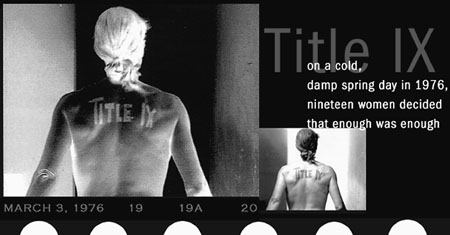The History of Title IX

Executive Order 11246 was amended by President Johnson, effective October
13, 1968, to include discrimination based on sex and was renamed “Executive
Order 11246 (1965) as amended by Executive Order 11375 (1967).” Bernice
R. Sandler, at the time a part-time lecturer at the University of Maryland
and currently a senior scholar in residence at the National Association
for Women in Education, was the first to use the order for the benefit
of women. “I had made the connection,” she noted, “that,
since most universities and colleges had federal contracts, they were
forbidden from discriminating in employment on the basis of sex.”
Ignited by Sandler’s efforts, on March 9, 1970, Rep. Martha Griffiths
(D-Michigan) gave the first speech in the U.S. Congress concerning discrimination
against women in education. Three weeks later, the first contract compliance
investigation involving sex discrimination began at Harvard University.
In June and July 1970, Rep. Edith Green (D- Ohio), who chaired the subcommittee
that dealt with higher education, drafted legislation prohibiting sex
discrimination in education and held the first congressional hearings
on the education and employment of women. The hearings that Rep. Green
held were the first legislative step toward the enactment of Title IX.
The original version of the bill, which was part of a larger measure on
higher education, proposed to amend Title VII of the 1964 Civil Rights
Act (prohibiting discrimination in employment on the basis of race, color,
religion, sex, or national origin) to cover employees in educational institutions.
The measure also proposed to amend Title VI of the Civil Rights Act (prohibiting
discrimination on the basis of race, color, or national origin in any
program receiving federal financial assistance) to cover sex discrimination,
and to extend the Equal Pay Act to cover executives, administrators, and
professionals. When the hearings were finished, Rep. Green asked Sandler
to join the committee staff to put together the written record of the
hearings. Sandler thus became the first person ever appointed to the staff
of a congressional committee to work specifically in the area of women’s
rights.
The bill was managed in the Senate by Senators Birch Bayh (D-Indiana)
and George McGovern (D-South Dakota). The House-Senate conference committee
took several months to settle differences between the House and Senate
education bill. Honoring the requests of African American leaders and
their supporters, who feared that the process of amending Title VI could
weaken its coverage, Rep. Green proposed a separate and new title, which
became the now famous Title IX.
The technical wording of the bill made it difficult to understand
at a quick glance and discussion on the Senate floor included whether
the bill would require educational institutions to allow women to play
football. Not imagining the potential impact of Title IX on athletics,
when their concerns about football were allayed, higher education did
not lobby for or against the bill. Sandler and the bill’s other supporters
did not lobby on its behalf either in order to avoid attracting adverse
attention. The elementary and secondary education community remained for
the most part unaware of it because it was attached to a higher education
measure.
This article was found at: http://www2.edu.org



